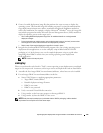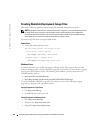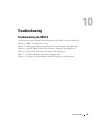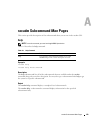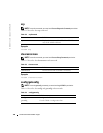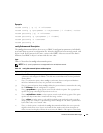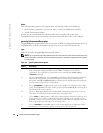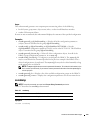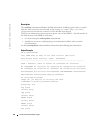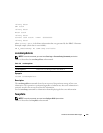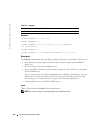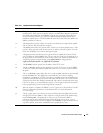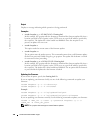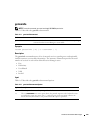
152 racadm Subcommand Man Pages
www.dell.com | support.dell.com
Output
This subcommand generates error output upon encountering either of the following:
• Invalid syntax, group name, object name, index, or other invalid database members
• racadm CLI transport failures
If errors are not encountered, this subcommand returns an indication of how many
configuration objects that were written out of how many total objects were in the .cfg file.
getconfig Subcommand Description
The getconfig subcommand allows the user to retrieve DRAC 4 configuration parameters on an
individual basis, or all the configuration groups may be retrieved and saved into a file.
Input
Ta b le A-6 describes the getconfig subcommand options.
NOTE: The -f option will output the contents of the file to the terminal screen rather than writing to a file
since no file system is available. For the serial/telnet console, the <filename> argument must be supplied,
but it is ignored.
Table A-6. getconfig Subcommand Options
Option Description
-f The -f <filename>, or filename option, causes getconfig to create the file <filename>. It
then reads all the configuration data from the DRAC 4 and places it into the file
<filename>. The created file is a format that can be used with the racadm config -f
<filename> command.
-p The -p, or password option, causes getconfig to include password information in the file for
all passwords except for the user passwords (which are stored encrypted and cannot be
decrypted). A # cfgUserAdmPassword line is displayed as an indication that the password is
present, but the password text is not displayed.
-g The -g <groupName>, or group option, can be used to display the configuration for a single
group. The groupName is the name for the group used in the racadm.cfg files. If the group is
an indexed group, use the -i option.
-h The -h, or help option, displays a list of all available configuration groups that you can use.
This option is useful when you do not remember exact group names.
-i The -i <index>, or index option, is valid only for indexed groups and can be used to specify a
unique group. The <index> is a decimal integer from 1 through 16. If -i <index> is not
specified, a value of 1 is assumed for groups, which are tables that have multiple entries. The
index is specified by the index value, not a "named" value.
-u The -u <username>, or user name option, can be used to display the configuration for the
specified user. The <username> option is the log in user name for the user.




